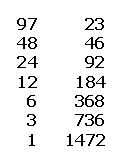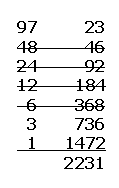Essentially the technique converts the first factor into binary, multiplies each of its constituents by the second factor, and sums the results.
Imagine that each line is associated with a power of 2: the first line with 20, the second with 21,and so on.
The business in the first column, halving the first factor successively and crossing out those lines with even numbers, effectively reduces the first factor to its binary constituents — here, the lines that remain are those associated with 20, 25, and 26, and, sure enough, 20 + 25 + 26 = 97.
Now we need to multiply each of those constituents by the second factor, 23. In other words, we want to find:
(23 × 20) + (23 × 25) + (23 × 26)
That’s what’s accomplished in the second column. Doubling the second factor successively, as we’ve done there, is equivalent to multiplying it by 20 in the first line, by 21 in the second, and so on. That is, 23 = 23 × 20, 46 = 23 × 21, etc. And the lines that haven’t been crossed out are precisely the ones we want:
23 (= 23 × 20)
736 (= 23 × 25)
1472 (= 23 × 26)
So if we add those values, we’ll get the product of the original two numbers, which is what we sought: 23 + 736 + 1472 = 2231.
Here’s essentially what we’ve done, from the top:
97 × 23
= (20 + 25 + 26) × 23
= (23 × 20) + (23 × 25) + (23 × 26)
= 23 + 736 + 1472
= 2231
It works with any pair of numbers.


